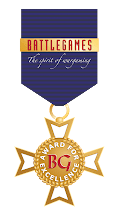The Knights' Tomb by Tony Harwood
First Published in 2012
Originally published on Barking Irons Online back in July 2012, this article had been lost when BIO was shut down but I have included it here in full.
Introduction
Following on from the earlier Modelling Masterclass, I was thinking about how I could model some more graveyard structures and came across some coarse, semi-flat 30mm/35mm metal castings that were given to me some years ago. The souvenir or Toy Figurines come from Prague and are of a mounted knight on horseback and two duelling knights on foot. I decided to build a simple box tomb and place the two fighting soldiers on top.
Construction
The main structure is built up from a couple of wooden blocks and clad with cardboard. I cut the card panels with a new scalpel blade and used PVA glue to attach them to the wooden block. The technique is quite easy – if time consuming. I cut out a number of simple rectangular shapes, each overlapping the earlier one and with a slightly larger aperture in the sides, the effect when multiplied can give stunning effects. In total I used five layers, but you can decide to increase or decrease this.
Further detailing
The top and bottom of each side is further modelled with yet another layer of card. It is a very easy technique, just take your time.
In the initial plan I was going to use the two foot soldiers and these can be seen placed on top of the card-clad tomb. The recess in the top was designed to hide the figures bases.
Change of direction
For the final model I decided to use the mounted figure and have attached the metal horse to the tomb lid with superglue. The lid is 3mm thick plastic card with a rough rectangle removed from the centre. When the horse was fitted, I filled the spaces with Milliput Fine White and smoothed out the join. Additional detailing to the tomb sides was done with either cardboard or plastic rod sliced into thin discs.
Modelling the base
I have mounted the card-clad tomb onto a lower level of 3mm plastic card and further attached this to an oval base made from even more 3mm thick plastic card. Keen-eyed readers will see that between the tomb base and the groundwork I have added a piece of tile-textured wallpaper and built up the groundwork with DAS modelling clay.
In an attempt to blend the tomb into the groundwork, I have used PVA glue applied with a stiff brush and 'stippled' onto the groundwork and tomb.
I am planning on using the two foot soldiers in a future modelling project.
The next step was to add the rider. This was done with superglue and the small gaps filled with ‘green stuff’. I have also textured the base by adding sieved sand and small stones over dilute PVA glue.
Painting
The painting was carried out in my usual manner, a very dark undercoat of black and dark brown which was roughly painted on with a large brush. I added some fine sand to the paint and brushed this over the tomb and base but not over the horse and rider.
At this stage of the build, I thought the tomb sides looked a little bare and have added some small card squares to the upper sides. Once the glue had set fully, I painted them in the same dark brown basecoat.
The first highlight was 'scrubbed-on' dark brown, black with a little cream coloured acrylic paint added to the mix.
The second highlight was the same as the previous, but with a little more cream added.
Final highlight
The third highlight was as before but with some Skull White added and applied with a drybrushing action, just picking out the upper edges and the fine detail.
A subtle palette
Throughout the painting of the tomb and statue I have tried to keep the colours subtle and avoid a stark or pure white highlight.
Snakebite Leather - where would I be without it?
The groundwork was painted with Snakebite Leather from GW and highlighted with touches of Skull White added to the mix. Individual stones have been picked out in grey – blended from Chaos Black and Skull White and then highlighted with a little Skull White.
Varnishing and flocking
After varnishing with Galleria Matt Varnish I have added coloured sawdust or flock which I add to all my terrain pieces so that they blend in with my gaming table.
This is the third of my Modelling Masterclasses to feature
graveyard terrain pieces, but as all three articles employ slightly different
techniques, I would hope they are of use and act as inspiration. If nothing else – we
all have a couple of figures that can easily be employed as statues. So why not try producing a similar model yourself.
Tony
Updated;
06.10.18 now using sub-headings



















































